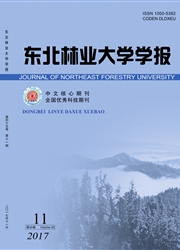

 中文摘要:
中文摘要:
采用样线调查法对40~80a不同林龄次生林繁殖鸟类群落结构开展了研究。结果表明:随着林龄的增加,次生林繁殖鸟类群落组成有显著差异,不同林龄次生林的优势种不同。不同林龄鸟类群落的Simpson多样性指数差异极显著,Shannon—Wiener多样性指数差异显著,二者均呈现早期上升、中期下降、后期增加并趋于稳定的变化趋势。Pielou均匀度指数差异不显著。40a次生林与50a次生林的繁殖鸟类共有种最少,相似性系数最低,70a次生林与80a次生林的繁殖鸟类共有种最多,相似性系数最高。
 英文摘要:
英文摘要:
We investigated the breeding bird community structure in five secondary forests with different stand ages (40-80 a) using the fine intercept method. The the community species composition varied significantly between five secondary forests with different stand ages, and the dominant species were different. Simpson bird diversity index and Shannon-Wiener bird diversity index in forests with different stand ages differed significantly, which all increased at early stage, then declined at medium stage, and became stable at mature stage. The Pieiou evenness index of bird communities in forests with different stand ages did not differ significantly, Pielou evenness index increased rapidly at first, then declined slowly, and reached a maximum at 60 a. There were fewest common species and lowest similarity coefficient between the 40-a forest and the 50- a forest; however, there were the most common species and the highest similarity coefficient between 70-a and 80-a forest.
 同期刊论文项目
同期刊论文项目
 同项目期刊论文
同项目期刊论文
 期刊信息
期刊信息
